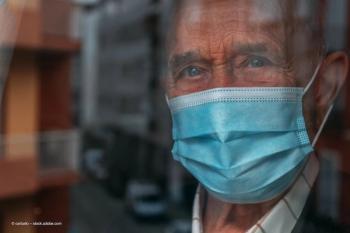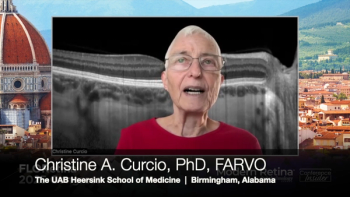Much of the clinical conference circuit is characterised by innovation. New pharmaceutical developments, technological innovations and advanced techniques are frequent topics on congress podiums. However, the fundamental skills of ocular surgery are worth keeping in focus. That precept is proven in high-conflict areas, such as urban centres of war.
Across the globe, some of the world's most skilled surgeons do not have the luxury to innovate or explore new avenues of eyecare. Instead, they are forced to operate without adequate supplies, with makeshift tools and sometimes even without electricity. This burden takes on more weight due to the high prevalence of ocular damage among patients who are the victim of blast injuries.
Oksana Vitovska, MD, is head of the ophthalmology department at the Bogomolets National Medical University in Kyiv, Ukraine. At the PAN Ophthalmologica 2025 Congress in New Delhi, India, Prof Vitovska co-moderated a symposium which focused on ocular trauma care in combat zones. Here, she shares key takeaways from her own experiences and from her colleagues.
Prof Vitovska demonstrates the importance of fundamental skills for every clinician—not just those operating in high-conflict areas—and illuminates actions the ophthalmic community can take to support their at-risk colleagues.
Hattie Hayes, Ophthalmology Times Europe: Can you provide a brief overview of the cases presented during the “Eye surgery necessitated by war injuries” symposium?
Oksana Vitovska, MD: During the symposium, we heard from ophthalmic surgeons who worked both in first-line hospitals and in hospitals far from the conflict zone. As a rule, in a conflict zone, the main focus is on saving the life of a defender and providing primary care. Doctors shared their experience of managing combat eye traumas and presented a range of cases of severe ocular injuries, including open wounds, intraocular foreign bodies, chemical burns and complex orbital fractures.
Many cases involved shrapnel wounds or blast injuries, both of which are rarely seen in civilian settings but are tragically common in war zones. The speakers gave us an insight into emergency and reconstructive procedures, highlighting the ingenuity and resilience required when standard resources are not available (Figure).
HH: How do the surgical interventions used here differ from those that could be used in traditional healthcare settings?
OV: Providing ophthalmic care in a combat environment is significantly different from a typical one. First of all, these are patients with various polytraumas; not only the eyes are affected, but also the nervous system, internal organs and limbs. Therefore, patients are sorted according to their life-threatening conditions. As a result, ophthalmological care is often delayed.
Another difference is the difficulty of evacuating soldiers and casualties under active shelling and drone attacks. The next is the limited resources. In conflict settings, there is often no access to general anaesthesia, electrocautery or even a stable power supply for microscopes or imaging tools. Surgeons have to adapt to unstable or makeshift surgical environments, visualisation may be limited and instruments may be improvised.
Of course, the severity of the lesions is also a difference. Most injuries are of a high degree of severity. Every third patient suffering from mine injuries is blind in one eye. Despite these limitations, the commitment to saving sight, and lives, remains unchanged.
HH: How can clinicians make quick decisions about interventions for eye trauma?
OV :Rapid triage is essential. After identifying life-threatening conditions, clinicians should prioritise based on the “three P's.” Those are: pain, perforation and potential for visual recovery. Open injuries, active bleeding and chemical burns require immediate attention. Even in resource-limited settings, a basic light perception test and pupillary reflexes can help guide decision-making. The key is to know which injuries are salvageable and which need to be stabilised for further referral. Clinical intuition based on trauma experience is invaluable when time and tools are limited.
The beginning of the war exposed gaps in the preparedness of civilian and military medical systems to deal with such complex ophthalmic injuries. Ukrainian ophthalmologists face challenges such as a lack of specialised equipment, limited access to high-resolution imaging (e.g., optical coherence tomography, orbital CT scans), difficulties in organising rapid and safe patient transport and the need to make urgent surgical decisions in austere conditions. But after almost 3.5 years of full invasive aggression, ophthalmologists accumulated great experience. At the same time, it should be reminded that daily attacks on medical facilities, hospitals and energy infrastructure lead to a continuous decrease in access to highly qualified eye care in the frontline areas.
Staged interventions allow for life- and vision-saving treatment while minimising risk of complications. Initial surgery might focus on wound closure and infection prevention. Secondary procedures like vitrectomy or lens implantation occurr later, when inflammation is controlled and proper tools or specialists become available. This phased approach reduces stress on ocular tissue and gives patients a better prognosis, even if initial visual outcomes are modest. Most cases are challenging as the practicing surgeons need anterior and posterior globe surgery skills.
HH: Which fundamental skills are particularly important in a resource-limited environment?
OV: In combat environments and resource-limited areas, clinical acumen becomes more important than advanced diagnostics.
Key skills include:
- Basic visual acuity assessment, even with improvised charts
- Pupillary testing for afferent defects
- Direct ophthalmoscopy
- Accurate wound assessment and foreign body detection
- Manual suturing and globe repair techniques under local anaesthesia
These skills can be practiced regularly in civilian trauma centres or even through simulation workshops. In fact, we strongly advocate for hands-on trauma training as part of general ophthalmology education.
HH: What are the most-needed resources in combat areas?
OV: We urgently need both material and human support. On the technological side: portable slit lamps, battery-powered microscopes, headlamps and basic surgical packs are essential. We always need tactical glasses, which save eyes and vision. On the human side, there’s a dire need for retina and cornea specialists, oculoplastic surgeons and general ophthalmologists trained in trauma care. We would like to thank all our international colleagues, who, despite the threats, come to Ukraine, help our doctors in complicated surgery cases, teach them and share their experience gained in other military conflicts.
A call to action: We encourage clinicians globally to support mission-based outreach—either through short-term fieldwork or by offering remote guidance and mentorship. Training programmes for local surgeons, especially in countries like Ukraine, are crucial for building sustainable eye care in the face of ongoing conflict. The problem of ocular trauma, in the context of war, is not only a medical and clinical issue. It is a profound human, social and scientific challenge.
The development of comprehensive solutions for prevention, early diagnosis, effective treatment and long-term rehabilitation is essential both during wartime and for post-war recovery. The experience gained under such extreme conditions must be carefully studied and disseminated, contributing to international knowledge in ophthalmology, military medicine and trauma care
Ocular Trauma in Wartime: Statistics
- The eyes occupy 0.1 % of the total body surface
- Ocular injuries sustained in war are bilateral in 15 to 25% of cases
- Visual prognosis from ocular primary blast injury is poor with a final visual acuity of 6/12 or better in 16–32% of cases
- Injuries in the anterior segment generally carry a better prognosis than those in the posterior segment and optic nerve
Reference: Scott R. The injured eye. Philos Trans R Soc Lond B Biol Sci. 2011;366(1562):251-260. doi:10.1098/rstb.2010.0234
HH: Few clinicians find themselves in high-conflict settings. What do you wish more clinicians globally knew about this high-risk, urgent work?
OV: That it is both deeply humbling and profoundly human. The resilience of patients and the dedication of clinicians working under fire are astonishing. It’s easy to take sterile operating rooms and support teams for granted, until you witness someone suturing a globe injury by flashlight. Basic skills and simple tools can save a person’s sight, their livelihood or even their dignity. Global solidarity in ophthalmology is not just aspirational—it’s essential.
One final point we’d like to emphasise is the long-term burden of ocular trauma. Vision loss from war injuries doesn’t just affect individuals—it impacts families, communities, and entire healthcare systems. Rehabilitation, psychological support, and access to visual aids must be part of the care continuum. And importantly, we must work toward not just emergency response, but post-conflict rebuilding: training local experts, establishing referral networks and making sure no one is left behind.
I would like to express my deep gratitude to Sibylle Scholtz, PhD, for her initiative in organising the symposium, for her constant support and coverage of the state of Ukrainian ophthalmology during the brutal war of Russia against Ukraine. Dr Scholtz also provided support in the development and composition of this article.
I am grateful to the organising committee of the PAN Ophthalmologica Congress and Dr Arun Sethi for supporting this idea and highlighting our topical issue in the programme of the event.
Oksana Vitovska, MD | E: [email protected]
Vitoskova leads the ophthalmology department at the Bogomolets National Medical University in Kyiv, Ukraine, and is head of the Ukrainian Alliance of Ophthalmologists.
Sibylle Scholtz, PhD | E: [email protected]
Scholtz is a subject matter expert of biometry and IOL power calculation. She is an asociated senior research fellow at the Institute of Experimental Ophthalmology, Saarland University, Homburg/Saar, Germany.








































